
The FPJ Big 50 Products ranks the 50 best-selling fresh fruit and vegetable products by sales value, using Kantar Worldpanel data for the 52 w/e 21 May 2017.
31. Spring onions
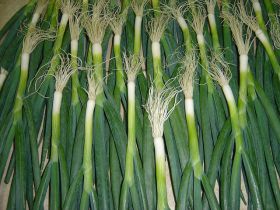
Versatility puts the spring in onions
Value: £84.1m (+8.3%) Volume: 21.9m kg (+3.7%)
Versatility and a combined usage at both hot and cold meal occasions are believed to be behind the recent success of spring onions, which have seen value sales grow by almost double figures in the last year.
“Spring onions have done well, particularly through winter,” says marketing director at G’s, Anthony Gardiner. “We saw strong demand and value and volume growth across the retailers. It would seem like there’s stronger growth in winter than summer, which suggests there is an increase in people cooking stir fries at home.”
In general, retailers are strengthening their offer in stir fries, says Gardiner, which is leading to favourable shelf space for spring onions.
“At 62 per cent penetration it’s a core product,” he continues. “It’s also had a really strong spring. Bunched spring onions deflated a few years ago, then it plateaued, so it’s a good value product.”
On the growing side, Andrew Hartley of Red Star Growers says crop quality is good, aside from thrips issues seen earlier this year. “Uptake from our customers is growing. Lots of people use spring onions in cooking, and the recent good, dry weather will encourage people to eat salad,” he says.
32. Asparagus
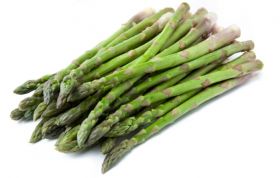
Is asparagus the next avocado?
Value: £78m (+4.7%) Volume: 9.2m kg (+4.2%)
Wealthy, versatile, trendy, available year round – you could be forgiven for thinking this is further praise for industry darling avocado, but it could just as easily be applied to asparagus.
With an Enjoy Asparagus campaign focused on year-round availability for the first time, there is every chance to build on the strong five-year picture of 6.1 per cent year-on-year growth.
At the recent Biennial Asparagus Conference, Kantar Worldpanel’s Emma Fencott told growers that linking the product to breakfast and brunch, emphasising its versatility and raising awareness to bring in new shoppers could see sales skyrocket in a similar way to avocados.
British growers are upbeat about the possibilities too, despite some issues around weed control, according to Matt Spanton of Wayborough Farm in Kent, and the inevitable worries about sourcing seasonal labour.
The last year’s sales figures were positive, but volume sales were a little depressed by the fact that shoppers have been switching to smaller pack sizes – some 45.6 per cent of packs sold are now under 200g, according to Fencott, with tips and fine asparagus growing in popularity. And if growers, supermarkets and marketers can really seize the opportunity, this is one product where the sky is the limit.
33. Sweet potatoes
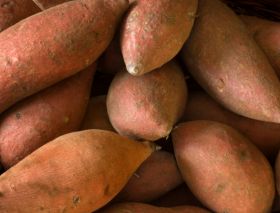
Versatile product continues to find new friends
Value: £76.1m (-1.7%) Volume: 71.6m kg (+14.9%)
Sweet potatoes are one of the vogue foods of the day, and their phenomenal success has spawned a huge range of new SKUs from frozen and ready meals to crisps, fries and even liquors.
Consumers are still buying in ever-increasing quantities, as near 15 per cent year-on-year volume growth testifies, but growers are concerned at particularly low prices which have seen value sales decline by 1.7 per cent. That’s partially explained by greater than expected availability from the US, bringing more crop onto the European markets, but the figures are less than ideal.
Stan Smith, chief executive of Scott Farms International, says that the core wholehead product has received a boost from the myriad other lines now available, as well as the fact that sweet potato fries have become ubiquitous on restaurant menus. “One of the key volume drivers overall has been the growth in the processing industry,” he explains. “That’s very good for consumers overall because it’s increased awareness, and you’ve now virtually got entire cabinets in supermarkets dedicated to the product as well.”
The category also received a fillip when McCain ran an advert as part of its sponsorship of Emmerdale for two consecutive weeks, featuring a family tucking into sweet potato fries.
34. Leeks
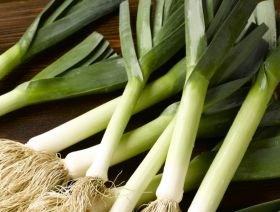
Next gen key for leek future
Capturing the attention of the younger generation is key to a healthy future for leeks, which has traditionally featured in soups, stews and other winter food prepared by older consumers.
The sector has seen solid sales growth over the last year, driven by the continued switch away from loose product and towards pre-packs as well as raised awareness on the back of an industry marketing campaign that has focused on the versatility of leeks and attracting younger shoppers.
“It’s reassuring to see the category growing,” says Tim Casey from the Leek Growers’ Association. “For a while the category was shrinking but that switch into pre-packs has helped increase values. It’s going in the right direction.”
The rise in the popularity of home cooking kits could offer a further boost to the sector, according to Casey, with leeks easy to prepare and not as sharp an ingredient as onions.
The core product is not easy to innovate, though some growth could come from the largely imported baby leek market, in addition to sliced and diced lines. “The majority of innovation will be in terms of packaging and processed products,” adds Casey. “It’s not a product that changes too much, but I’d expect to see loose sales fall further and pre-packs climb.”
35. Celery
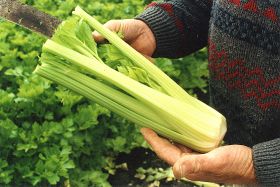
A deflationary tale for celery
Value: £70.6m (-4.5%) Volume: 54.4m kg (+5.9%)
With a value decline of 4.5 per cent over the last year, celery is experiencing what other commodity salad veg categories have already been through: deflation among major retailers to drive volume and compete with the discounters.
On the plus side, as volumes have grown, penetration has crept up over 50 per cent and frequency of purchase has also risen, according to G’s marketing director Anthony Gardiner. Future growth will now come from promoting the versatility of celery across both hot and cold meal occasions, he says.
“What we’re seeing with celery is there is a fair bit of deflation within the category. In the last 52 weeks we’ve seen the major mults dropping the price of whole stick celery and that is driving volume and driving new customers into the category,” says Gardiner.
“This has been achieved through devaluation of the core product, so we’re also seeing a bit of a trade down into whole sticks and a movement away from other products. It’s broadly in line with what’s happening in the other commodities.”
Growing conditions were tough for celery over the winter with the weather issues in Spain, but with the year-round Love The Crunch campaign keeping the product in front of consumers, there is plenty of opportunity for future growth.



